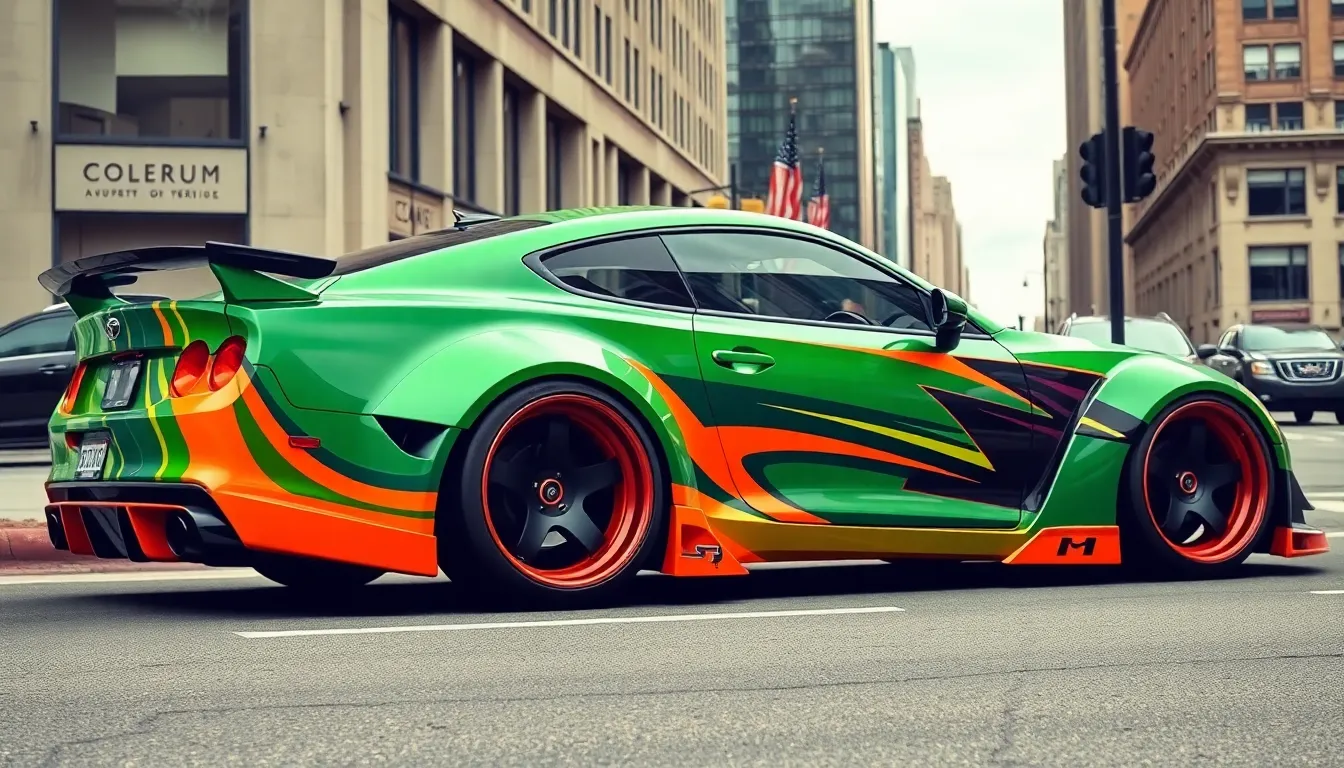We’ve all seen those jaw-dropping cars that seem to dominate every inch of asphalt they touch. Widebody cars aren’t just vehicles – they’re rolling works of art that blend aggressive styling with enhanced performance capabilities. These modified machines feature dramatically flared fenders, extended side skirts, and wider wheel wells that accommodate massive tire setups.
The widebody transformation has exploded in popularity among car enthusiasts who crave that perfect balance of form and function. Whether you’re drawn to the menacing stance of a widebody Challenger or the track-ready aggression of a modified sports car, these builds represent the pinnacle of automotive customization.
But widebody modifications aren’t just about looks. We’re talking about improved aerodynamics, better handling characteristics, and the ability to run wider tires for superior grip. From bolt-on kits to custom fabricated masterpieces, the widebody industry offers endless possibilities for creating your dream machine.
What Are Widebody Cars and Why Are They So Popular?
We’re witnessing an automotive revolution where widebody cars have transformed from niche racing applications into mainstream performance modifications. These aggressive builds have captured the hearts of enthusiasts worldwide through their perfect blend of visual impact and functional enhancement.
Definition of Widebody Modifications
Widebody modifications extend a vehicle’s original width through carefully engineered exterior components. Flared fenders replace stock bodywork to accommodate significantly wider wheels and tires. Extended side skirts connect these elements while creating a cohesive visual flow along the vehicle’s profile. Wider rear quarters house larger tire setups that wouldn’t fit within factory specifications.
Factory widebody packages come directly from manufacturers like Dodge, Porsche, and McLaren. These OEM answers integrate seamlessly with the vehicle’s original design language. Aftermarket widebody kits offer more dramatic transformations through companies like Liberty Walk, Rocket Bunny, and Pandem. Custom fabrication allows builders to create completely unique widebody designs customized to exact vision and performance goals.
Installation methods range from reversible bolt on systems to permanent modifications. Overfender kits attach to existing bodywork without cutting or welding. Full widebody conversions require professional bodywork and paint matching for factory quality finishes. Riveted installations create distinctive industrial aesthetics popular in stance and drift communities.
Benefits of Widebody Kits for Performance and Aesthetics
Performance gains come through increased tire contact patch and improved aerodynamics. Wider tires provide better grip during acceleration, braking, and cornering maneuvers. Enhanced stability occurs at highway speeds due to the lower center of gravity and wider track width. Track focused builds benefit from reduced lap times through superior mechanical grip and reduced body roll.
Aerodynamic improvements include better airflow management and increased downforce. Front splitters and canards direct air around the wider body for reduced drag coefficients. Side skirts create ground effect tunnels that enhance high speed stability. Rear diffusers work with the extended bodywork to manage turbulent airflow behind the vehicle.
Visual transformation creates commanding road presence that turns heads everywhere. Aggressive stance gives vehicles a planted, performance oriented appearance. Muscular proportions enhance the perception of power and capability. Custom paint schemes and graphics complement the widebody aesthetic for truly unique builds.
Wheel fitment possibilities expand dramatically with widebody modifications. Deep dish wheels up to 13 inches wide fit within the extended fenders. Staggered setups allow different front and rear wheel sizes for optimized handling characteristics. Exotic wheel designs previously impossible become viable options for creating show stopping builds.
Most Iconic Widebody Cars From Factory Production

Factory widebody cars represent the pinnacle of manufacturer engineering excellence. These vehicles arrive from the production line with aggressive stance modifications that enthusiasts typically achieve through aftermarket upgrades.
Porsche 911 Turbo and GT Series
Porsche’s 911 Turbo models showcase the German automaker’s mastery of factory widebody design through their distinctive flared rear fenders. We’ve witnessed decades of evolution in these iconic sports cars, with each generation featuring increasingly aggressive bodywork that accommodates wider rear tires ranging from 305mm to 325mm widths.
The 911 GT3 and GT2 variants take factory widebody aesthetics to another level with their track focused aerodynamic packages. These models feature extended front splitters, pronounced side skirts, and massive rear wings that create a cohesive widebody appearance straight from Stuttgart’s production facilities.
Current generation 911 Turbo S models deliver 640 horsepower while maintaining their signature wide rear stance that’s been a Porsche trademark since the 1970s. The factory widebody design houses the sophisticated all wheel drive system and provides the necessary clearance for the car’s advanced suspension geometry.
Dodge Challenger and Charger Hellcat Models
Dodge revolutionized the American muscle car segment with their factory widebody Hellcat variants that transform ordinary sedans and coupes into street dominating machines. We see these models featuring aggressive fender flares that accommodate massive 305mm rear tires, creating an intimidating presence that matches their supercharged performance credentials.
The Challenger SRT Hellcat Widebody produces 717 horsepower while its extended bodywork houses a sophisticated suspension system designed for both straight line acceleration and improved cornering capabilities. Dodge engineers widened the rear track by 3.5 inches compared to standard Challenger models, resulting in dramatically improved stability during high speed driving.
Charger SRT Hellcat Widebody variants bring the same aggressive styling treatment to the four door platform with flared fenders that extend the car’s overall width by 3.5 inches. These factory modifications aren’t purely cosmetic as they enable the fitment of wider performance tires that significantly enhance the vehicle’s grip and handling characteristics.
BMW M3 and M4 Competition Variants
BMW’s M3 and M4 Competition models feature subtle yet effective factory widebody treatments that enhance both performance and visual appeal through carefully sculpted fender extensions. We observe how BMW’s approach differs from more aggressive American and German counterparts by integrating widebody elements into the car’s overall design language seamlessly.
The current generation M3 Competition showcases widened rear fenders that accommodate 285mm rear tires while maintaining the sedan’s elegant proportions. BMW engineers extended the rear track width to improve high speed stability and cornering performance, resulting in lap time improvements over standard M3 variants.
M4 Competition models feature similar widebody enhancements with additional aerodynamic elements including front splitters and rear spoilers that complement the extended bodywork. These factory modifications contribute to the car’s impressive performance capabilities, including a 0 to 60 mph acceleration time of just 3.8 seconds and enhanced track day prowess that rivals purpose built sports cars.
Top Aftermarket Widebody Kit Manufacturers

We’ve explored factory widebody offerings, but the aftermarket scene delivers even more dramatic transformations. These leading manufacturers push creative boundaries with their distinctive approaches to widebody design.
Liberty Walk’s Aggressive Styling Approach
Liberty Walk revolutionizes widebody aesthetics with their signature overfenders and dramatic stance modifications. Their kits feature exposed bolt-on fender flares that create an unmistakably aggressive appearance, transforming everything from Lamborghini Huracáns to Nissan GT-Rs into street warriors. We see their designs emphasizing extreme proportions with deep dish wheels and lowered suspensions that complement their wide fender extensions.
Founded by Kato-san in Japan, Liberty Walk’s philosophy centers on creating maximum visual impact through bold design choices. Their kits typically include front and rear overfenders, side skirts, and rear spoilers that work together to create a cohesive widebody package. We appreciate how their designs maintain functionality while delivering show-stopping aesthetics that command attention at car shows and on public roads.
Rocket Bunny’s Japanese-Inspired Designs
Rocket Bunny brings a distinctly Japanese tuning philosophy to widebody modifications with their smooth, flowing lines and integrated design approach. Their kits feature seamless fender flares that blend naturally with vehicle proportions, creating a factory-like appearance that enhances rather than dominates the original design. We notice their attention to aerodynamic functionality with carefully sculpted air vents and ducting that improve cooling and reduce drag.
Kei Miura’s design house focuses on creating widebody kits that look like they could have rolled off the production line. Their approach emphasizes subtle curves and integrated mounting systems that eliminate the bolt-on appearance common in other aftermarket offerings. We value their commitment to both form and function, with each kit designed to accommodate exact wheel sizes and suspension setups for optimal performance.
Prior Design’s European Elegance
Prior Design delivers sophisticated widebody answers that emphasize European luxury and refinement in their aesthetic approach. Their kits feature carbon fiber construction and precision fitment that maintains the elegant proportions of high-end vehicles like BMW M cars and Mercedes-AMG models. We observe their focus on subtle enhancement rather than dramatic transformation, creating widebody packages that enhance prestige rather than overshadowing it.
Based in Germany, Prior Design specializes in aerodynamic packages that improve both performance and visual appeal through carefully engineered components. Their widebody kits include front splitters, side skirts, and rear diffusers that work together to create downforce while maintaining luxury vehicle sophistication. We recognize their commitment to quality with hand-laid carbon fiber construction and precise panel gaps that rival factory specifications.
Essential Components of Widebody Car Modifications
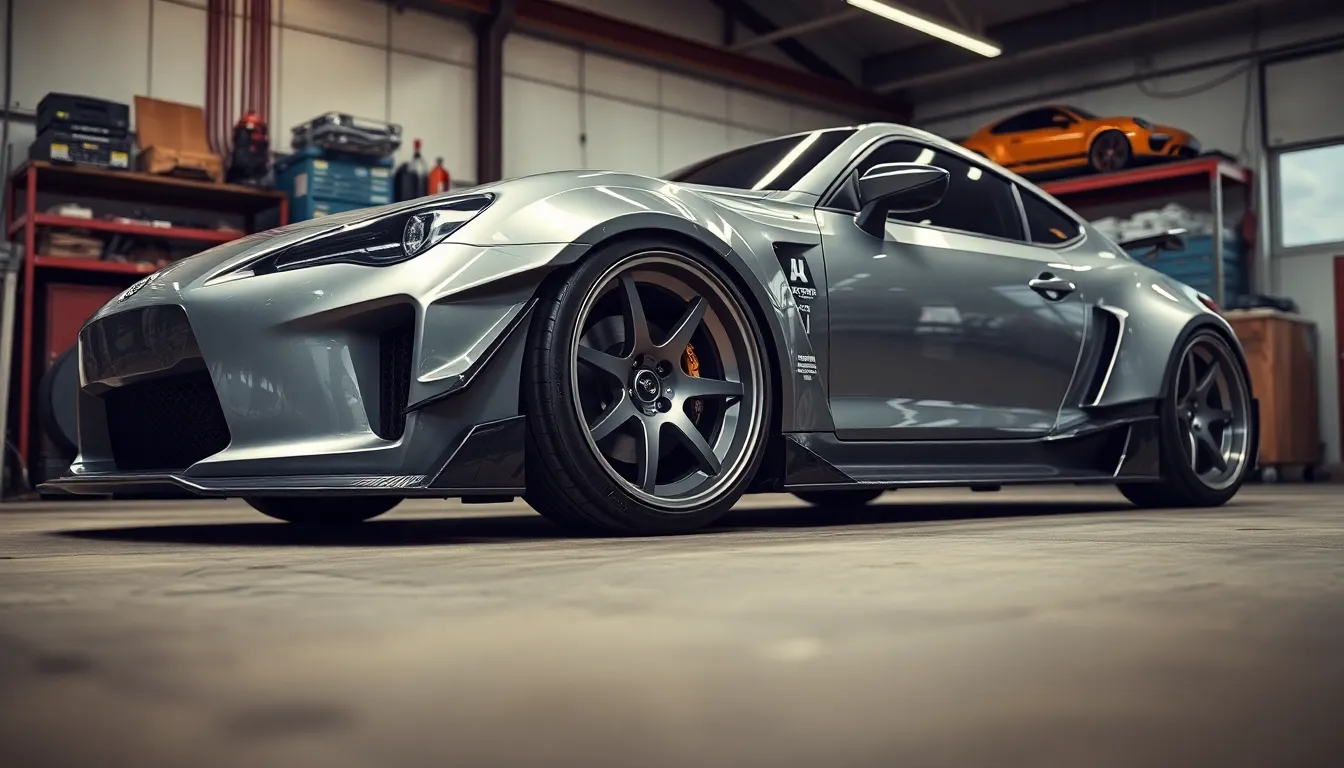
Building on the foundation of understanding widebody aesthetics and benefits, we’ll examine the critical components that make these transformations successful. Each modification works together to create both the desired appearance and enhanced performance capabilities.
Fender Flares and Side Skirts Installation
Fender flares serve as the cornerstone of any widebody transformation, extending the vehicle’s original bodywork to accommodate wider wheels and tires. We typically see two primary installation methods: bolt-on kits that attach to existing mounting points and riveted designs that create a more permanent connection to the vehicle’s body panels.
Side skirts complement the fender modifications by extending the lower body lines and creating visual continuity along the vehicle’s profile. Installation requires precise measurements to ensure proper alignment with the extended fender flares and maintain the vehicle’s aerodynamic flow.
Professional installers often recommend test fitting all components before final mounting to verify panel gaps and alignment. The process typically involves drilling exact mounting points and may require minor trimming of existing body panels to achieve perfect fitment with the widebody components.
Wheel Fitment and Offset Considerations
Wheel selection becomes critical when implementing widebody modifications, as the extended fenders create opportunities for significantly wider tire contact patches. We need to calculate proper offset measurements to ensure wheels sit flush with the new fender lines while maintaining adequate suspension clearance.
Front wheel specifications typically range from 19×9.5 to 20×11 inches depending on the vehicle platform, while rear applications often accommodate 19×11 to 20×13 inch configurations. Offset calculations must account for the additional fender width, usually requiring more aggressive offsets than stock applications.
Tire sizing follows the increased wheel dimensions, with many builders opting for square setups that use identical tire sizes front and rear for improved handling balance. Common tire sizes include 295/30R19 for moderate widebody applications and 335/25R20 for more extreme builds that maximize the available fender space.
Suspension Modifications for Proper Stance
Suspension adjustments play a vital role in achieving the proper stance and maximizing the visual impact of widebody modifications. We typically install coilover suspension systems that provide both ride height adjustment and spring rate customization to complement the wider track width.
Camber adjustment becomes essential with widebody setups, as the wider wheels and lower ride heights require negative camber to maintain proper tire contact patches during cornering. Most applications benefit from 2 to 4 degrees of negative camber depending on the intended use and tire specifications.
Air suspension systems offer additional flexibility for street driven vehicles, allowing owners to raise the vehicle for daily driving and lower it for shows or spirited driving sessions. These systems integrate seamlessly with widebody aesthetics while providing practical functionality for various driving scenarios.
Performance Benefits of Widebody Cars
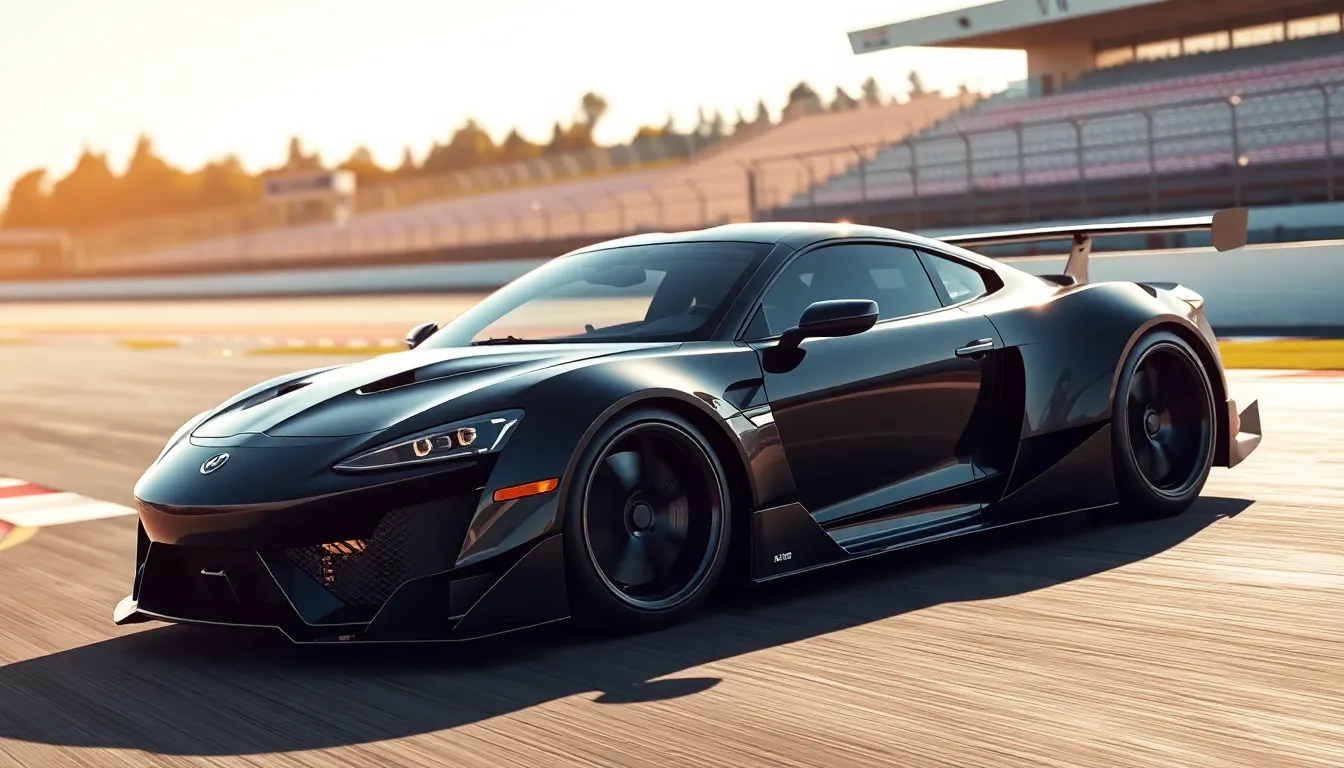
Widebody modifications deliver substantial performance advantages that extend far beyond their striking visual appeal. We’ll explore how these engineered enhancements transform a vehicle’s ever-changing capabilities through improved aerodynamics, enhanced grip, and superior handling characteristics.
Improved Aerodynamics and Downforce
Widebody designs create more efficient airflow management around the vehicle’s expanded silhouette. Extended fender flares and wider side skirts channel air more effectively along the car’s flanks, reducing turbulence that typically occurs at the factory body’s edges. This improved air management generates additional downforce, particularly at higher speeds where aerodynamic forces become increasingly critical.
Integrated splitters and diffusers work synergistically with the widened body panels to maximize aerodynamic efficiency. Front air dams redirect airflow underneath the vehicle while rear diffusers accelerate air exiting from beneath the car, creating a low pressure zone that pulls the vehicle toward the pavement. Professional wind tunnel testing shows that properly designed widebody kits can increase downforce by 15-25% compared to stock configurations.
Side skirts eliminate air spillage that occurs when air flowing along the vehicle’s sides escapes underneath the chassis. These extended panels create a more controlled airflow path, preventing the high pressure air above the car from mixing with the low pressure air beneath it. Racing applications demonstrate that sealed side skirts can improve overall aerodynamic efficiency by reducing drag coefficients significantly.
Enhanced Tire Contact Patch and Grip
Wider tires enabled by widebody modifications dramatically increase the contact patch between rubber and asphalt. Factory vehicles typically compromise tire width to accommodate narrow fender wells, but widebody builds allow for significantly broader rubber compounds. Performance testing shows that increasing tire width from 245mm to 315mm can improve lateral grip by up to 20%.
Specialized tire compounds maximize the benefits of increased contact patch area through advanced rubber formulations. Track focused tires like Michelin Pilot Sport Cup 2 and Toyo Proxes R888R use sticky compounds that work optimally with the increased surface area that widebody fitments provide. These combinations deliver measurable improvements in braking distances and cornering speeds.
Temperature management improves substantially with wider tire configurations because heat dissipates across a larger surface area. Narrower tires concentrate heat buildup in smaller contact patches, leading to performance degradation during aggressive driving. Wider setups maintain more consistent grip levels during extended track sessions or spirited canyon runs.
Better Weight Distribution and Handling
Wider track widths inherent in widebody builds lower the vehicle’s center of gravity and improve stability characteristics. Extended fender lines accommodate wheels with different offsets, pushing the contact patches further from the vehicle’s centerline. This increased track width reduces body roll during cornering and creates more predictable handling dynamics.
Suspension geometry benefits significantly from the additional clearance that widebody modifications provide. Engineers can carry out more aggressive camber angles and suspension travel without interference from factory fender wells. Performance oriented setups often incorporate negative camber settings between 2-4 degrees, maximizing tire contact during cornering loads.
Weight distribution improvements occur naturally when wider wheels and tires move mass further from the vehicle’s central axis. This distribution reduces the polar moment of inertia, making the car more responsive to steering inputs and improving overall agility. Track testing consistently shows faster transition times and improved slalom performance in properly executed widebody builds.
Popular Car Models for Widebody Conversions
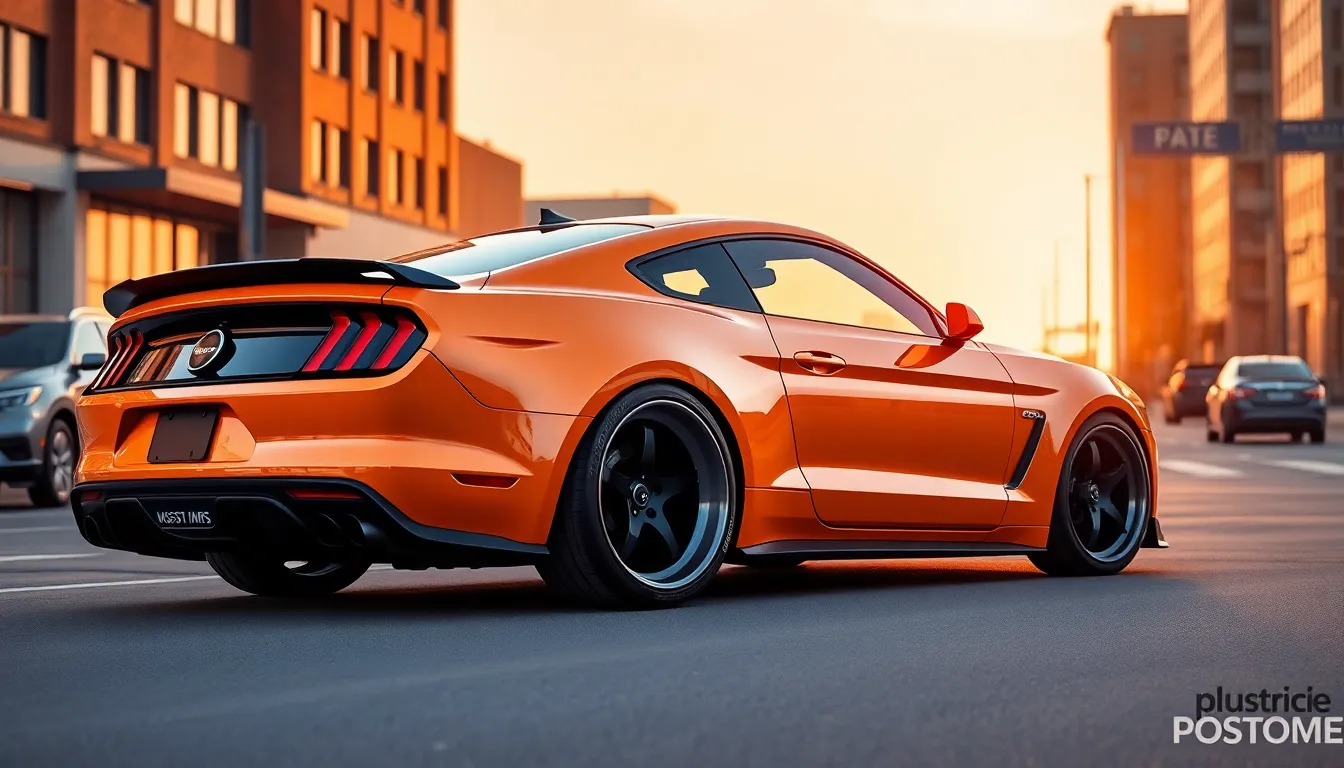
We’ve identified the most sought-after platforms that offer exceptional potential for widebody transformations. These vehicles provide the perfect foundation for creating stunning visual statements while maximizing performance capabilities.
Japanese Sports Cars: Nissan GT-R and Subaru WRX
Nissan GT-R models dominate the widebody conversion scene with their aggressive factory lines and robust all-wheel-drive platform. Liberty Walk and Rocket Bunny have created some of the most recognizable GT-R widebody kits, featuring dramatic overfenders that accommodate 12-inch wide wheels. We see conversions ranging from subtle 2-inch extensions to extreme 6-inch flares that completely transform the vehicle’s silhouette.
Subaru WRX and STI variants offer incredible versatility for widebody enthusiasts seeking rally-inspired aesthetics. These platforms typically receive 3-4 inch fender extensions that complement their naturally muscular proportions. Custom fabricators often incorporate functional hood scoops and side vents into WRX widebody builds, creating authentic motorsport appearances that enhance both cooling and visual impact.
Both platforms benefit significantly from the additional tire contact patch that widebody modifications provide. GT-R conversions frequently run 315mm rear tires, while WRX builds commonly use 285mm all around for optimal grip distribution.
American Muscle: Ford Mustang and Chevrolet Camaro
Ford Mustang widebody conversions represent the perfect marriage of classic American styling and modern performance enhancement. Companies like Clinched Flares and Anderson Composites have developed bolt-on systems that add 3-5 inches of width per side. We particularly appreciate how Mustang widebody kits maintain the vehicle’s iconic proportions while accommodating massive 335mm rear tires.
Chevrolet Camaro platforms showcase dramatic transformation potential through widebody modifications. Factory ZL1 1LE models provide inspiration for aftermarket conversions that often exceed OEM specifications. Custom builds frequently feature 4-6 inch fender extensions combined with aggressive front splitters and rear diffusers.
Installation on American muscle cars typically involves more straightforward bolt-on procedures compared to exotic platforms. Both Mustang and Camaro conversions can accommodate air suspension systems that allow owners to adjust ride height for different driving scenarios.
European Exotics: Lamborghini and Ferrari Models
Lamborghini Huracán widebody conversions have achieved legendary status among enthusiasts worldwide. Liberty Walk’s iconic bolt-on flare design transforms the sleek Italian supercar into an aggressive street weapon with exposed hardware and dramatic proportions. These conversions typically add 4-6 inches of total width while maintaining the vehicle’s sophisticated lines.
Ferrari models present unique challenges for widebody conversions due to their complex aerodynamic systems and refined aesthetics. Prior Design has developed sophisticated kits for models like the 488 GTB that enhance width by 2-3 inches per side while preserving the manufacturer’s elegant design language. Custom carbon fiber work ensures these modifications complement rather than compete with the original bodywork.
Both platforms require specialized expertise during installation due to their complex electrical systems and precision-engineered components. We recommend working with certified installers who understand the intricacies of European exotic vehicles to ensure optimal results and maintain vehicle reliability.
Cost Considerations for Widebody Car Projects
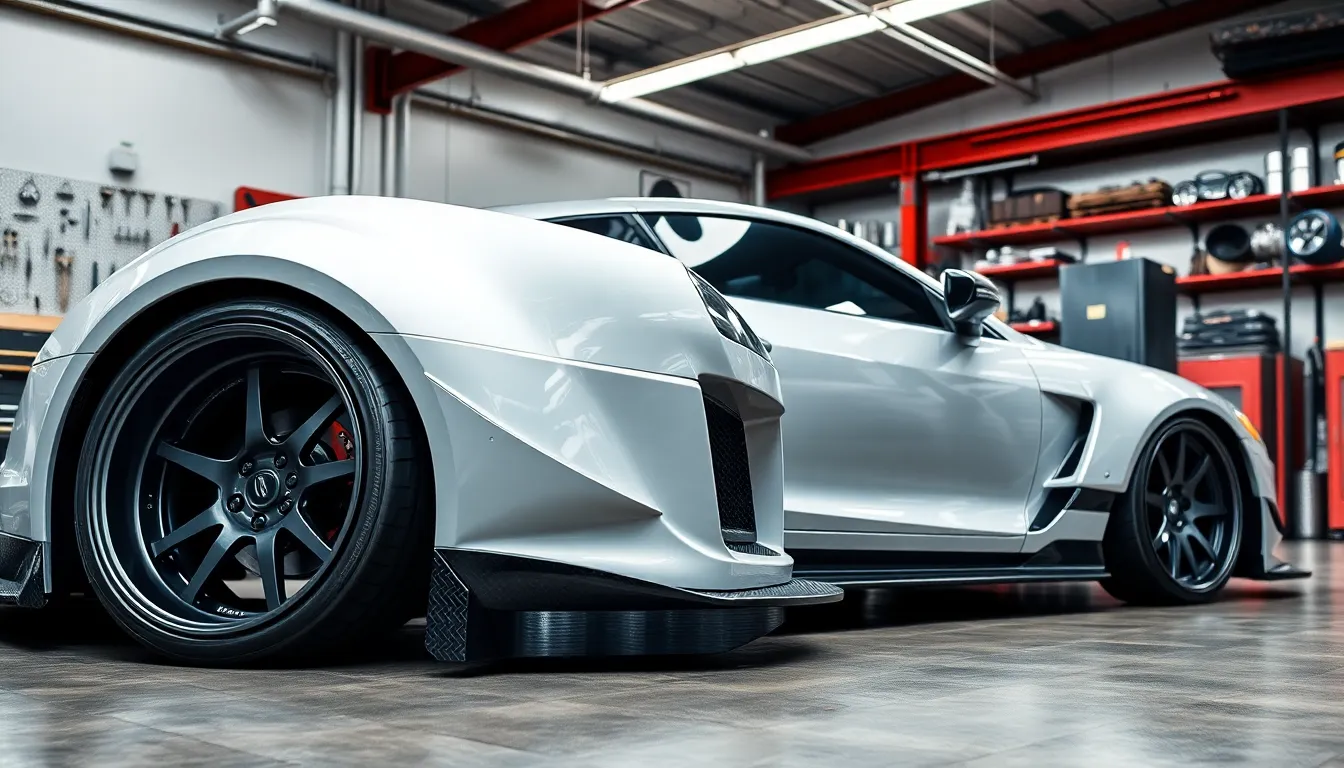
Understanding the financial investment required for widebody modifications helps us make informed decisions about our project scope and timeline.
Budget-Friendly Bolt-On Options
Basic bolt-on widebody kits represent the most accessible entry point into widebody modifications, typically ranging from $1,500 to $5,000 for complete packages. Popular manufacturers like Pandem and Rocket Bunny offer universal fender flare systems that attach using existing mounting points without requiring permanent bodywork modifications. These kits usually include front and rear fender extensions, side skirts, and basic hardware for installation.
Entry-level fiberglass kits provide excellent value for enthusiasts working with limited budgets, offering dramatic visual transformation without very costly. Companies such as Duraflex and Extreme Dimensions produce affordable alternatives that deliver impressive results when properly installed and painted. Urethane-based options cost slightly more but offer better flexibility and durability for daily-driven vehicles.
Installation costs for bolt-on systems typically add $800 to $2,500 to the total project expense, depending on paint requirements and local labor rates. Many enthusiasts choose primer-finished kits to reduce initial costs, planning to complete painting at a later date when budget allows. Additional expenses include wider wheels and tires, which can range from $2,000 to $6,000 depending on size and brand preferences.
High-End Custom Fabrication Expenses
Custom widebody fabrication represents the pinnacle of modification artistry but requires substantial financial investment, with projects often exceeding $15,000 to $50,000 or more. Skilled fabricators create bespoke designs customized to exact vehicle requirements, incorporating complex curves and integrated bodywork that seamlessly blends with factory panels. These projects involve extensive metalwork, custom mold creation, and precision engineering to achieve perfect fitment and finish quality.
Premium materials significantly impact project costs, with carbon fiber components commanding prices 3-5 times higher than fiberglass alternatives. Professional fabrication shops charge $100 to $200 per hour for skilled metalwork, with complex widebody builds requiring 80-150 hours of labor depending on design complexity. High-end paint work adds another $5,000 to $15,000 to the total investment, particularly when matching factory colors or applying custom finishes.
Show-quality builds often incorporate additional modifications such as custom air ride systems, bespoke interior work, and engine performance upgrades that can double the overall project cost. These investments create truly unique vehicles that command attention at car shows and represent important assets within the enthusiast community. Timeline considerations also affect costs, as rush jobs typically incur 25-50% premium charges from reputable fabrication shops.
Professional Installation vs. DIY Approaches
Professional installation guarantees proper fitment and finish quality but adds substantial cost to widebody projects, typically ranging from $3,000 to $8,000 for complete kit installation and painting. Experienced shops possess specialized tools, spray booths, and technical expertise necessary for achieving seamless integration between aftermarket components and factory bodywork. These professionals understand critical details such as panel gaps, paint matching, and structural reinforcement requirements.
DIY installation appeals to mechanically inclined enthusiasts seeking cost savings, potentially reducing total project expenses by 40-60% compared to professional work. Basic hand tools, cutting implements, and painting equipment represent the primary investment requirements for home installations. YouTube tutorials and online forums provide valuable guidance, though success depends heavily on individual skill levels and available workspace quality.
Hidden costs often emerge during DIY projects, including specialized tools, additional materials, and correction work when initial attempts don’t meet expectations. Professional-grade paint equipment rental can cost $200-500 per week, while quality primer, paint, and clear coat materials add $800-1,500 to material expenses. Time investment becomes crucial, as DIY installations typically require 3-5 times longer completion periods compared to professional shops, potentially stretching projects across multiple months.
Hybrid approaches offer compromise answers, with enthusiasts handling basic prep work and bolt-on installation while outsourcing complex tasks like paint work to professionals. This strategy can reduce costs by 20-30% while ensuring critical finishing work meets quality standards. Insurance considerations also matter, as some policies may not cover damage resulting from unprofessional modifications or installations.
Maintenance and Care for Widebody Cars
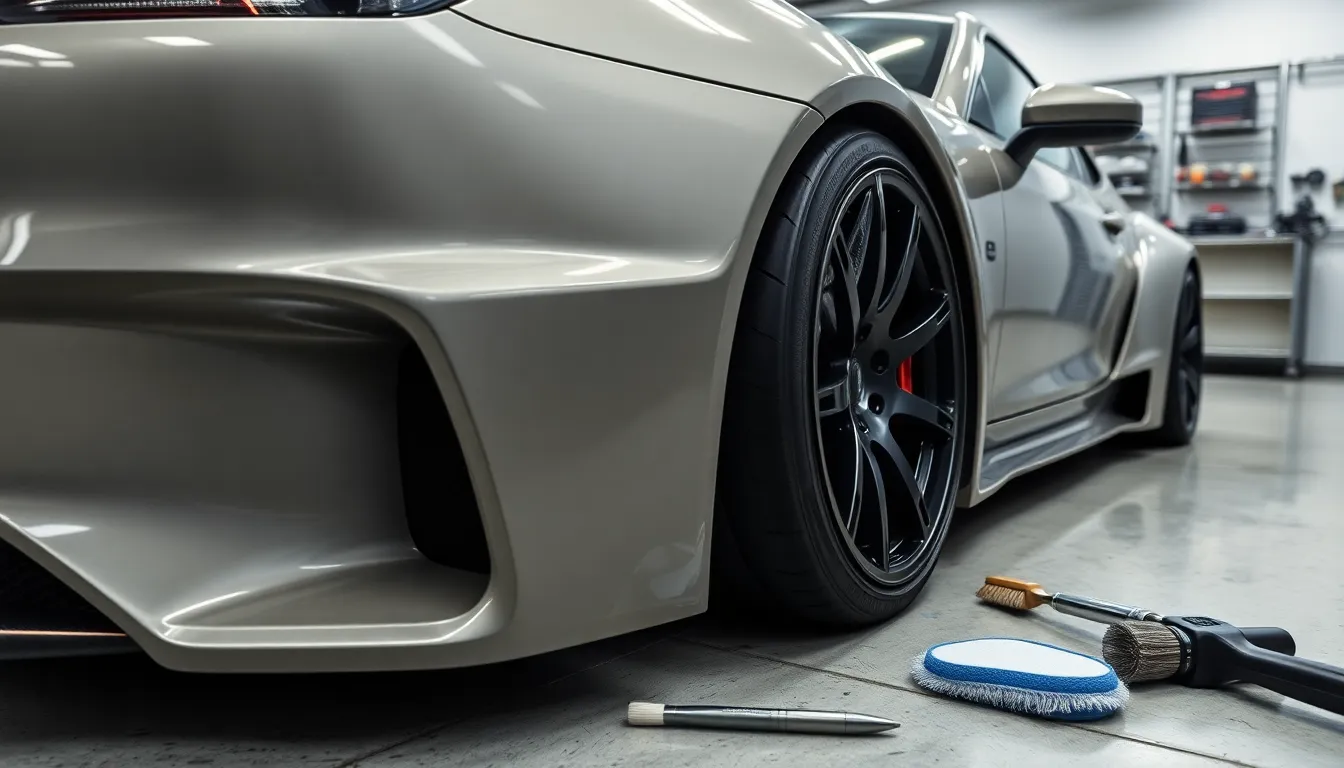
Owning a widebody car requires specialized maintenance approaches that differ from standard vehicle care. Understanding these unique requirements ensures our modified vehicles maintain their performance benefits and stunning appearance for years to come.
Protecting Wide Fenders from Damage
Parking strategies become critical when protecting widebody fenders from door dings and curb damage. We recommend parking farther from building entrances and choosing end spots in parking lots to minimize contact with other vehicles.
Stone chip protection preserves the integrity of our widebody panels through clear protective films or ceramic coatings. Companies like XPEL and 3M offer exact films designed for curved fender surfaces that resist impact damage while maintaining paint clarity.
Garage storage prevents weather-related deterioration of fiberglass and carbon fiber components. Temperature fluctuations can cause expansion and contraction that leads to cracking in lower quality materials over time.
Regular inspections catch mounting hardware looseness before it becomes costly damage. We check bolt-on fender flares monthly for secure fitment, paying special attention to areas where vibration might cause hardware to work loose.
Cleaning and Detailing Considerations
Specialized cleaning tools reach into the complex curves and crevices of widebody designs more effectively than standard equipment. Detailing brushes with varying bristle lengths help access areas between fender extensions and body panels where dirt accumulates.
Pressure washing techniques require modified approaches around widebody components to prevent water intrusion behind panels. We maintain safe distances of 18-24 inches from seams and use lower pressure settings around mounting points.
Wax application demands extra attention on textured surfaces common in aftermarket widebody kits. Microfiber applicators work better than foam pads on carbon fiber weaves and aggressive styling lines found in Liberty Walk or Rocket Bunny designs.
Wheel well cleaning becomes more complex with extended fender coverage requiring specialized access angles. Long-handled brushes and flexible detailing tools help reach areas that wider fenders now conceal from direct access.
Insurance and Legal Implications
Modification disclosure to insurance providers prevents claim denials when accidents occur with widebody vehicles. We document all modifications with photos and receipts, providing insurers with accurate replacement cost estimates that typically increase premiums by 15-25%.
State inspection requirements vary significantly for vehicles with body modifications, requiring research into local regulations. Some states mandate engineering certifications for substantial width increases, while others prohibit certain types of fender extensions entirely.
Liability concerns arise from widebody cars that exceed original manufacturer specifications, potentially affecting fault determinations in accidents. Proper documentation proves modifications meet safety standards and don’t compromise vehicle integrity.
Specialized insurance options through companies like Hagerty or Grundy offer agreed-value policies that recognize modification investments. These policies typically cost 20-30% more than standard coverage but provide guaranteed payouts reflecting true vehicle value including our widebody enhancements.
Conclusion
Widebody cars represent the perfect marriage of aggressive styling and enhanced performance that continues to captivate automotive enthusiasts worldwide. Whether you’re drawn to factory offerings from manufacturers like Porsche and Dodge or prefer the creative freedom of aftermarket answers from Liberty Walk and Rocket Bunny these modifications deliver undeniable presence and improved capabilities.
The investment in widebody conversions extends far beyond aesthetics. We’ve seen how these modifications provide measurable performance gains through improved aerodynamics wider tire contact patches and enhanced stability that transforms how vehicles handle on both street and track.
Success with widebody builds requires careful planning from selecting the right platform and components to understanding installation costs and ongoing maintenance requirements. With proper execution and care these stunning machines reward owners with years of driving enjoyment and head-turning appeal that few modifications can match.
Frequently Asked Questions
What are widebody cars and how do they differ from regular vehicles?
Widebody cars feature extended fenders, wider wheel wells, and flared bodywork that increases the vehicle’s overall width beyond factory specifications. These modifications accommodate wider tires and wheels while improving aerodynamics. Unlike regular vehicles, widebody cars offer enhanced grip, better handling, and a more aggressive appearance through engineered exterior components.
What are the main performance benefits of widebody modifications?
Widebody modifications provide improved aerodynamics, increased tire contact patches for better grip, enhanced stability through wider track widths, and reduced center of gravity. These changes result in better cornering performance, improved braking capabilities, superior weight distribution, and increased downforce generation for enhanced high-speed stability.
How much does a widebody conversion typically cost?
Budget-friendly bolt-on widebody kits range from $1,500 to $5,000, plus $800-$2,500 for installation. Mid-range custom projects can cost $8,000-$15,000, while high-end custom fabrication exceeds $15,000-$50,000. DIY approaches can save 40-60% on labor costs but require significant time and skill investment.
Which car models are best suited for widebody conversions?
Popular widebody platforms include Japanese sports cars (Nissan GT-R, Subaru WRX), American muscle cars (Ford Mustang, Chevrolet Camaro), and European exotics (Lamborghini, Ferrari models). These vehicles offer strong aftermarket support, proven performance capabilities, and aesthetic designs that complement widebody modifications effectively.
What are the top aftermarket widebody kit manufacturers?
Leading manufacturers include Liberty Walk (known for aggressive bolt-on designs), Rocket Bunny (Japanese-inspired seamless integration), and Prior Design (sophisticated European elegance). Each brand offers unique styling approaches, from exposed fastener aesthetics to factory-like appearances, catering to different enthusiast preferences and vehicle applications.
What maintenance considerations are unique to widebody cars?
Widebody cars require careful parking to protect extended fenders, regular inspections of modification integrity, specialized cleaning techniques, and garage storage when possible. Owners should use protective films, monitor for stress cracks, and ensure proper documentation for insurance purposes. Professional maintenance may be needed for complex systems.
Are there legal and insurance implications for widebody modifications?
Yes, owners must disclose modifications to insurance companies and understand local regulations regarding body modifications. Some areas have restrictions on vehicle width or require safety inspections. Specialized insurance coverage may be necessary to protect the investment, and proper documentation of all modifications is essential for coverage.
Can I install a widebody kit myself or should I hire professionals?
While DIY installation is possible for mechanically inclined enthusiasts, professional installation ensures proper fitment, alignment, and finish quality. DIY can save significant costs but requires specialized tools, workspace, and expertise. A hybrid approach, where some tasks are DIY and complex work is professional, offers a balanced solution.

